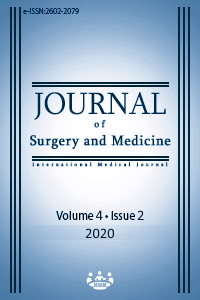Trends in lung cancer incidence within the last 10 years: An Eastern Anatolian single center experience
Keywords:
Lung cancer, Histopathology, IncidenceAbstract
Aim: Lung cancer is the most common cause of cancer-related deaths among men and women, and mortality and morbidity rates vary according to different histological groups. Therefore, histological type determination is extremely important. The purpose of the study is to investigate the histological subtypes of lung cancer cases within the last 10 years in one of the biggest centers of the Eastern Anatolian Region, considering the changes made in the 2015 updates in lung tumors by World Health Organization (WHO), and investigate the relationship between these histological sub-types and distribution according to year, gender and age.
Methods: In this cross-sectional study, patients who were referred for lung biopsy between January 2010 and December 2019 and diagnosed with lung carcinoma were retrospectively analyzed.
Results: Our study shows that the frequency of lung cancer, along with histological subtypes, has increased throughout the years. The most common lung cancer type, regardless of gender, is Squamous Cell Carcinoma (SCC), followed by Small Cell Lung Carcinoma (SCLC) and Adenocarcinoma. Adenocarcinoma and SHC were the most common subtypes among females and males, respectively. A significant relationship was observed between gender and histological type (P<0.001).
Conclusion: The data from our study suggest that the incidence of lung cancer increased throughout the years, similar to the data from our country and other developing countries around the world. In terms of subtypes, among developing countries, Adenocarcinoma rate increased while SCC rate decreased. In our study, the most common histological types increased at a similar rate. Adenocarcinoma was the most common lung cancer among females, similar to other developing countries. The most common lung cancer overall remained the same: SCC. This was considered an indication of the unchanged smoking habits of males.
Downloads
References
Miller KD, Nogueira L, Mariotto AB, Rowland JH, Yabroff KR, Alfano CM, et al. Cancer treatment and survivorship statistics, 2019. CA: a cancer journal for clinicians. 2019;69(5):363-85.
Noone A, Howlader N, Krapcho M, Miller D, Brest A, Yu M, et al. SEER cancer statistics review, 1975-2015. Bethesda, MD: National Cancer Institute. 2018.
Latimer K, Mott T. Lung cancer: diagnosis, treatment principles, and screening. American family physician. 2015;91(4):250-6.
Travis WD, Brambilla E, Nicholson AG, Yatabe Y, Austin JH, Beasley MB, et al. The 2015 World Health Organization classification of lung tumors: impact of genetic, clinical and radiologic advances since the 2004 classification. Journal of thoracic oncology. 2015;10(9):1243-60.
Goksel T, Akkoclu A. Pattern of lung cancer in Turkey, 1994-1998. Turkish Thoracic Society, Lung and Pleural Malignancies Study Group. Respiration. 2002;69:207-10.
Fitzmaurice C, Dicker D, Pain A, Hamavid H, Moradi-Lakeh M, MacIntyre MF, et al. The global burden of cancer 2013. JAMA oncology. 2015;1(4):505-27.
Barta JA, Powell CA, Wisnivesky JP. Global epidemiology of lung cancer. Annals of global health. 2019;85(1).
Lewis DR, Check DP, Caporaso NE, Travis WD, Devesa SS. US lung cancer trends by histologic type. Cancer. 2014;120(18):2883-92.
Goss PE, Strasser-Weippl K, Lee-Bychkovsky BL, Fan L, Li J, Chavarri-Guerra Y, et al. Challenges to effective cancer control in China, India, and Russia. The lancet oncology. 2014;15(5):489-538.
Osmani L, Askin F, Gabrielson E, Li QK, editors. Current WHO guidelines and the critical role of immunohistochemical markers in the subclassification of non-small cell lung carcinoma (NSCLC): Moving from targeted therapy to immunotherapy. Seminars in cancer biology; 2018: Elsevier.
Zheng M. Classification and pathology of lung cancer. Surgical Oncology Clinics. 2016;25(3):447-68.
Travis WD, Brambilla E, Noguchi M, Nicholson AG, Geisinger KR, Yatabe Y, et al. International association for the study of lung cancer/american thoracic society/european respiratory society international multidisciplinary classification of lung adenocarcinoma. Journal of thoracic oncology. 2011;6(2):244-85.
Brambilla C, Laffaire J, Lantuejoul S, Moro-Sibilot D, Mignotte H, Arbib F, et al. Lung squamous cell carcinomas with basaloid histology represent a specific molecular entity. Clinical Cancer Research. 2014;20(22):5777-86.
Travis WD, Brambilla E, Noguchi M, Nicholson AG, Geisinger K, Yatabe Y, et al. Diagnosis of lung adenocarcinoma in resected specimens: implications of the 2011 International Association for the Study of Lung Cancer/American Thoracic Society/European Respiratory Society classification. Archives of Pathology and Laboratory Medicine. 2013;137(5):685-705.
Myers DJ, Wallen JM. Cancer, Lung Adenocarcinoma. StatPearls (Internet): StatPearls Publishing; 2019.
Li C, Lu H. Adenosquamous carcinoma of the lung. OncoTargets and therapy. 2018;11:4829.
Youlden DR, Cramb SM, Baade PD. The International Epidemiology of Lung Cancer: geographical distribution and secular trends. Journal of Thoracic Oncology. 2008;3(8):819-31.
Bircan HA, Öztürk Ö, Şahin Ü, Özaydın N, Akkaya A. Akciğer kanseri tanısı alan olgularımızın Retrospektif değerlendirilmesi. SDÜ Tıp Fakültesi Dergisi. 2005;12(3):1-6.
Yurdakul AS, Çalışır HC, Demirağ F, Taci N, Öğretensoy M. Akciğer kanserinin histolojik tiplerinin dağılımı. Toraks Dergisi. 2002;3(1):59-65.
Downloads
- 731 1207
Published
Issue
Section
How to Cite
License
Copyright (c) 2020 Sevilay Özmen, Onur Ceylan
This work is licensed under a Creative Commons Attribution-NonCommercial-NoDerivatives 4.0 International License.
















